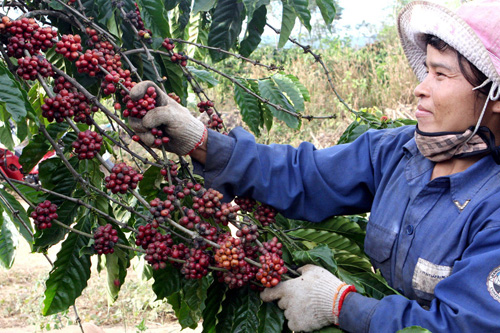Despite inflation and difficulties in trade, Việt Nam’s coffee exports recorded strong growth, according to experts, who expect a record US$4 billion in export value this year.
Despite inflation and difficulties in trade, Việt Nam’s coffee exports recorded strong growth, according to experts, who expect a record US$4 billion in export value this year.
According to the Ministry of Agriculture and Rural Development (MARD), coffee exports in the first nine months of 2022 reached nearly $3.1 billion, up 37.6 per cent over the same period last year. Export coffee prices rose nearly 22 per cent to an average of about $2,280 per tonne.
MARD’s data showed the European Union (EU) continued to be Việt Nam’s largest coffee consumption market with a market share of 39 per cent in the first eight months of the year, reaching nearly 490,700 tonnes with a value of $1.1 billion, an increase of over 27 per cent in volume and over 54 per cent in value from the same period a year ago.
According to the Institute of Policy and Strategy for Agriculture and Rural Development, in the EU, Việt Nam’s coffee exports to markets such as Belgium, Spain, the Netherlands, France, and Portugal have increased sharply compared with the same period last year. Despite inflation reaching a 20-year high, coffee exports to the EU still grew well.
The institute highlighted that coffee is an essential commodity, an indispensable drink of Western countries, and that the tariff reductions from the EU-Việt Nam Free Trade Agreement (EVFTA) also bring a great advantage for coffee exporters to this market.
Phan Minh Thông, chairman of Phúc Sinh Joint Stock Company, said that “coffee, like food, is an essential commodity for many countries so no matter how difficult it is, the demand still needs to be met. That has driven the growth of this item.”
Besides the EU, the amount of coffee exported to other markets also achieved impressive growth, including Russia up 17.3 per cent, the UK increased by 57.9 per cent, India increased by 116 per cent and Mexico spiked 52 times. In general, coffee exports to major markets increased as demand recovered after the COVID-19 pandemic, while global supply tightened due to crop failures and supply chain bottlenecks in some major producing countries.
Notably, the UK was the fifth largest coffee consuming market in Europe, after Germany, Italy, France and Spain. Việt Nam’s coffee exports accounted for a large chunk of the UK’s coffee imports, increasing sharply from 16.3 per cent in the first six months of 2021 to 29.9 per cent in the first six months of 2022, according to MARD data.
In the first eight months of 2022, Việt Nam’s coffee exports to the UK market reached 34,700 tonnes, worth $70.7 million, up 57.9 per cent in volume and 84.2 per cent in value over the same period in 2021. The free trade agreement between Việt Nam and the UK and Northern Ireland (UKVFTA) helped boost coffee export turnover to the UK market, said experts.
Regarding the US, the country still has high demand for coffee. Statistics from the US International Trade Commission said in the first six months of 2022, US coffee imports reached 833,960 tonnes, worth US$4.68 billion, up 5.4 per cent in volume and up 51.3 per cent in value over the same period in 2021. The average import price of Vietnamese coffee to the US reached $5,615/ton, up 43.5 per cent over the same period in 2021.
In terms of supply, the US increased coffee imports from main suppliers Colombia, Việt Nam and Guatemala but reduced imports from Brazil and Honduras, said the data.
In the Chinese market, instant coffee and ready-to-drink coffee are capturing a large market share thanks to convenience of use. Demand for coffee in China is growing at an average rate of 15 per cent per year.
Nguyễn Nam Hải, chairman of the Việt Nam Coffee and Cocoa Association, said that while other markets mainly imported green and raw coffee, China tended to import instant and processed coffee products. Therefore, Vietnamese businesses could focus on this segment to enhance added value.
Phan Minh Thông said the growth in coffee exports was also due to the fact that the global supply from the crop year 2021/2022 was lower than demand, as the world’s leading coffee supplier Brazil reduced coffee production.
“The Brazilian Coffee Exporters Association (Cecafe) forecasts that the country’s coffee stocks will only reach 7 million 60kg bags in March 2023 and be a record low for the world’s number one coffee producer,” Thông said.
Meanwhile, he said Việt Nam was about to enter the coffee harvest season 2022/2023, and forecast coffee output could increase by 10 per cent in the season.
Data from MARD showed local coffee yield has increased from 23.5 quintals/ha in 2011 to 28.2 quintals/ha in 2021 and output increased from 1.27 million tonnes in 2020 to 1.81 million tonnes in 2021. Currently, Việt Nam’s coffee yield was more than three times higher (2.8 tonnes/ha) than the world’s average coffee yield (0.8 tonnes/ha).
“The market demand for sustainable products is growing strongly, even 100 per cent every year, so this is an opportunity for businesses to produce and export coffee in particular and agricultural products in general,” Thông said.
Vietnamnews















